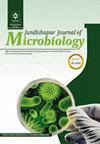微RNA-642a-5p靶向DNA损伤诱导转录本4抑制乙型肝炎病毒肝癌细胞
IF 0.5
4区 医学
Q4 MICROBIOLOGY
引用次数: 0
摘要
背景:肝细胞癌(HCC)是临床上最常见的恶性肿瘤之一,而乙型肝炎病毒(HBV)是HCC最常见的风险因素。微小RNA(miRNA)已成为疾病诊断和分子靶向治疗的新标记物;然而,miR-642a-5p在HBV相关HCC中的作用机制仍不清楚。研究目的本研究旨在探讨靶向DNA损伤诱导转录本4(DDIT4)的miR-642a-5p在HBV相关性HCC中的表达及其对HBV阳性HCC细胞增殖、迁移和侵袭的影响。方法:检测 HBV 相关肝癌(LC)患者血清中的 miR-642a-5p、LC 组织和细胞中的 miR-642a-5p 和 DDIT4 mRNA 以及 HBV 阳性细胞中的 HBV DNA。研究还考察了 miR-642a-5p 对 DDIT4 的靶向作用以及细胞的进展情况。所有细胞实验均重复五次。结果结果表明,在 HBV 阳性 HCC 患者的血清、组织和细胞中,miR-642a-5p 的水平降低,而 DDIT4 的水平升高。过表达 miR-642a-5p 可抑制 HBV 阳性 HCC 细胞的进展,抑制 HBV DNA 复制、细胞增殖和侵袭,并促进 HepG2.2.15 细胞凋亡。结论此外,miR-642a-5p 直接靶向 DDIT4,而 DDIT4 的敲除逆转了 miR-642a-5p 上调的效应,促进了 HBV 阳性 HCC 细胞的进展。总之,miR-642a-5p 在 HBV 相关的 HCC 中低水平表达,并通过靶向 DDIT4 抑制 HBV DNA 复制和 HBV 阳性 HCC 的肿瘤进展。这项研究为 HBV 阳性 HCC 的分子靶向治疗奠定了基础。本文章由计算机程序翻译,如有差异,请以英文原文为准。
MicroRNA-642a-5p Targets DNA Damage-Inducible Transcript 4 to Suppress Hepatitis B Virus Hepatoma Carcinoma Cell
Background: Hepatocellular carcinoma (HCC) is one of the most prevalent malignant tumors in clinical practice, with hepatitis B virus (HBV) being the most common risk factor for HCC. MicroRNAs (miRNAs) have emerged as a new marker for disease diagnosis and molecularly targeted therapies; however, the mechanism of miR-642a-5p in HBV-associated HCC remains unclear. Objectives: The aim of this study was to investigate the expression of miR-642a-5p, which targets DNA damage-inducible transcript 4 (DDIT4), in HBV-associated HCC, and its effect on the proliferation, migration, and invasion of HBV-positive HCC cells. Methods: miR-642a-5p in the serum of patients with HBV-associated liver cancer (LC), as well as miR-642a-5p and DDIT4 mRNA in LC tissues and cells, and HBV DNA in HBV-positive cells were detected. The targeting of DDIT4 by miR-642a-5p and the progression of cells were also examined. All cell experiments were repeated five times. Results: The results indicated that levels of miR-642a-5p were decreased, while levels of DDIT4 were increased in the serum, tissues, and cells of HBV-positive HCC patients. Overexpression of miR-642a-5p inhibited the progression of HBV-positive HCC cells, suppressed HBV DNA replication, cell proliferation, and invasion, and promoted apoptosis in HepG2.2.15 cells. Conclusions: In addition, miR-642a-5p directly targeted DDIT4, and knockdown of DDIT4 reversed the effects of miR-642a-5p upregulation, promoting the progression of HBV-positive HCC cells. In conclusion, miR-642a-5p is expressed at low levels in HBV-associated HCC and inhibits HBV DNA replication and tumor progression in HBV-positive HCC by targeting DDIT4. This study provides a foundation for molecular targeted therapy in HBV-positive HCC.
求助全文
通过发布文献求助,成功后即可免费获取论文全文。
去求助
来源期刊

Jundishapur Journal of Microbiology
MICROBIOLOGY-
CiteScore
1.30
自引率
0.00%
发文量
56
审稿时长
6-12 weeks
期刊介绍:
Jundishapur Journal of Microbiology, (JJM) is the official scientific Monthly publication of Ahvaz Jundishapur University of Medical Sciences. JJM is dedicated to the publication of manuscripts on topics concerning all aspects of microbiology. The topics include medical, veterinary and environmental microbiology, molecular investigations and infectious diseases. Aspects of immunology and epidemiology of infectious diseases are also considered.
 求助内容:
求助内容: 应助结果提醒方式:
应助结果提醒方式:


